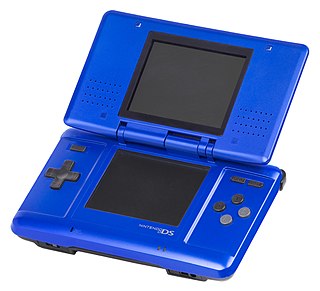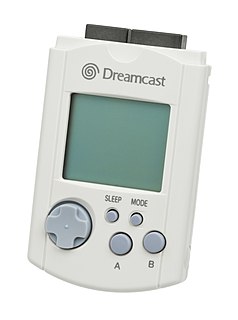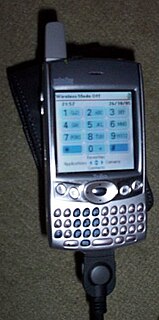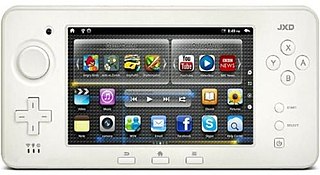
A handheld game console, or simply handheld console, is a small, portable self-contained video game console with a built-in screen, game controls and speakers. Handheld game consoles are smaller than home video game consoles and contain the console, screen, speakers, and controls in one unit, allowing people to carry them and play them at any time or place.

The Nintendo DS is a handheld game console produced by Nintendo, released globally across 2004 and 2005. The DS, an initialism for "Developers' System" or "Dual Screen", introduced distinctive new features to handheld games: two LCD screens working in tandem, a built-in microphone and support for wireless connectivity. Both screens are encompassed within a clamshell design similar to the Game Boy Advance SP. The Nintendo DS also features the ability for multiple DS consoles to directly interact with each other over Wi-Fi within a short range without the need to connect to an existing wireless network. Alternatively, they could interact online using the now-defunct Nintendo Wi-Fi Connection service. Its main competitor was Sony's PlayStation Portable during the seventh generation of video game consoles.

The Visual Memory Unit (VMU), also referred to as the Visual Memory System (VMS) in Japan and Europe, is the primary memory card produced by Sega for the Dreamcast home video game console. The device features a monochrome liquid crystal display (LCD), multiplayer gaming capability, second screen functionality, a real-time clock, file manager, built-in flash memory, and sound capability. Prior to the launch of the Dreamcast, a special Godzilla edition VMU, preloaded with a virtual pet game, was released on July 30, 1998, in Japan.

Treo 600 was a smartphone developed by Handspring, and offered under the palmOne brand after the merger of the two companies. Released in November 2003, it has a number of integrated features and it is possible to check the calendar while talking on the phone, dial directly from contacts list, take pictures or send emails. It includes a five-way navigation button and favorites screen allowing quick access to the phone functions.
A video game accessory is a distinct piece of hardware that is required to use a video game console, or one that enriches the video game's play experience. Essentially, video game accessories are everything except the console itself, such as controllers, memory, power adapters (AC), and audio/visual cables. Most video game consoles come with the accessories required to play games out of the box : one A/V cable, one AC cable, and a controller. Memory is usually the most required accessory outside of these, as game data cannot be saved to compact discs. The companies that manufacture video game consoles also make these accessories for replacement purposes as well as improving the overall experience. There is an entire industry of companies that create accessories for consoles as well, called third-party companies. The prices are often lower than those made by the maker of the console (first-party). This is usually achieved by avoiding licensing or using cheaper materials. For the mobile systems like the PlayStation Portable and Game Boy iterations, there are many accessories to make them more usable in mobile environments, such as mobile chargers, lighting to improve visibility, and cases to both protect and help organize the collection of system peripherals to. Newer accessories include many home-made things like mod chips to bypass manufacturing protection or homemade software.

Olympus m:robe was a product line of MP3 players that were produced by Olympus Corporation between 2004-2005. The name m:robe is a contraction of Music wardROBE. Olympus has ended production of the entire m:robe line. On October 13, 2004, Olympus released two MP3 players: the 5GB MR-100 with monochrome display and the 20GB MR-500i with colour display and built-in camera. The MR-100’s release price was $249.99 (USD), and the MR-500i’s release price was $499.99 (USD). The later MR-F10, MR-F20, and MR-F30 players with colour screens, drag-and-drop file transferring, and FM tuning and recording were only released in Asia.

Yepp was Samsung Electronics' digital audio player brand until Samsung decided to retire most of their family brands in February 2011. From then on, their MP3 players were simply branded "Samsung" worldwide until they discontinued all of them in late 2013. The brand included a wide range of hard-drive based as well as flash-memory based players. The name is claimed to be an acronym for "young, energetic, passionate person".

The Sony Reader was a line of e-book readers manufactured by Sony, who produced the first commercial E Ink e-reader with the Sony Librie in 2004. It used an electronic paper display developed by E Ink Corporation, was viewable in direct sunlight, required no power to maintain a static image, and was usable in portrait or landscape orientation.
Motorola Krzr, known as the "Canary" before its release, is a series of clamshell/flip mobile phones by Motorola, and is one of the series in the 4LTR line. The first phone was released in July 2006.
The Pocket Dream Console is a small handheld game console created by Conny in 2005. The system was released in Japan in 2006 by Takara Tomy. It is available in different colors.
Various accessories for the PlayStation 3 video game console have been produced by Sony and third-party companies. These include controllers, audio and video input devices like microphones, video cameras, and cables for better sound and picture quality.
The Motorola Razr2 (often stylized as RAZR2) is a series of clamshell/flip mobile phones from Motorola, and is one of the series in the 4LTR line. It is the successor to the popular Razr series. The Razr2 is 2 mm thinner than its predecessor but slightly wider. Some versions feature Motorola's MotoMagx operational platform, based on the MontaVista Linux OS. The Razr2 was made available on every US carrier, and EVDO, GSM and HSDPA versions of it were released by late 2007.

Sony Ericsson W205 is an entry-level dual-band GSM/GPRS Walkman phone with a focus on music playback. It was announced on 7 April 2009 under the marketing tag ‘your first Walkman phone’.

The Dingoo is a handheld gaming console that supports music and video playback and open game development. The system features an on-board radio and recording program. It is available to consumers in three colors: white, black, and pink. It was released in February 2009 and has since sold over 1 million units.

The Samsung Impression is a slider-style mobile phone manufactured by Samsung Electronics. First announced on March 30, 2009, it was released on April 7, 2009. It was the first phone manufactured for the United States to have an AMOLED touch-screen.

The Acer Iconia is a range of tablet computers from Acer Inc. of Taiwan.
Xbox is a video gaming brand created and owned by Microsoft. The brand consists of five video game consoles, as well as applications (games), streaming services, an online service by the name of Xbox network, and the development arm by the name of Xbox Game Studios. The brand was first introduced in the United States in November 2001, with the launch of the original Xbox console.

The JXD S5100 is a 5-inch Android tablet and portable game console produced by JXD. It was released in 2012 and resembles Nintendo's Wii U GamePad. Unlike the previous Sony-style JXD models, the S5100 lacks shoulder buttons.










